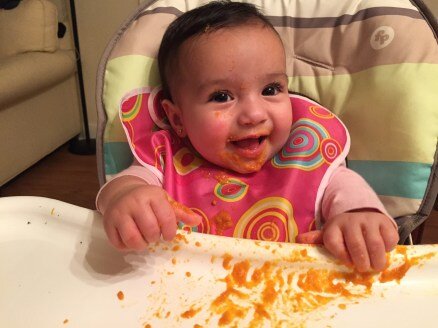Introducing Solids 101
Perhaps your baby is now sitting up, and interested in solid food, and you’ve been inundated with opinions and information about how to introduce solids. When is the right time? How should you do it? Should you give them rice cereal or something else first? What IS baby led weaning, anyway?
The American Academy of Pediatrics recommends introducing solids when infants are developmentally ready, usually between 4 and 6 months of age. Signs of readiness include good head control, losing the tongue thrust reflex, and showing interest in the solid food!
In terms of the specifics, let me reassure you; there is no “right approach”. Cultural practices, parent preferences, daily logistics and – most importantly – baby limitations and preferences, all play a role in deciding how to approach this next stage. And in fact, the vast majority of infants do fine regardless of how you introduce them to solids (note: this is true of many parenting decisions, even those that feel very final).
Introducing purees, or cereals, mixed with milk via a spoon is the most common method of introducing solids in the US. Given the myriad of commercially prepared options, and the variety of fancy blenders, providing traditional pureed baby food is easier than ever. But the concept of Baby Led Weaning (BLW), or allowing an infant to feed themselves finger food, is increasingly popular; it allows for introduction of a variety of textures, flavors, and allergens more easily and develops oro-motor skills, dexterity, and jaw strength.
We tried Baby Led Weaning for Moonbeam and Munchkin. Moonbeam was not excited about feeding herself solids, and we had many frustrating interactions before we switched to the more traditional approach (with purees). But ultimately we were all happier after the change, and she has ended up eating like any other vegetarian 5-year old! Munchkin, on the other hand, took to BLW like gangbusters!
None of the following is medical advice, and in fact there may be subtleties about your situation which would impact which approach is an appropriate choice for your infant.
In truth, there is no “best” first food. Like all humans, babies tend to have a preference for sweet things, and the order of introducing foods likely will not impact that preference. I do advise people to introduce a single food at a time to begin with so if there are any untoward reactions, it is easier to identify the potential trigger.
It is not unusual for an infant to reject a solid food initially. She may wrinkle her nose and turn away, and this is completely normal. Do not force her to eat, but definitely try the same food again at a different time. Take note of the situation if she rejects the food: was she starving and frustrated? You may need to take the edge off hunger with some milk before offering that solid again. Being Hangry makes us all less open to new experiences! Food should be fun, and it is important to keep things light, flexible, and positive.
A note on baby poop. Sometimes what comes out looks just like what went in, and that is okay! Immature guts may take time to regulate, and some infants have a transient period of constipation after starting solids. In most cases, this is easily remedied with a few oz of water via a sippy cup per day or 0.5-1oz of prune or pear juice (to clarify, infants and children do NOT need juice except in this circumstance). If the constipation is severe, or not improving, or if the stool seems excessively loose, watery, or full of mucous, it is important to discuss with your pediatrician.
Watch out for upcoming posts on Baby Led Weaning, and introducing allergens to your baby.

